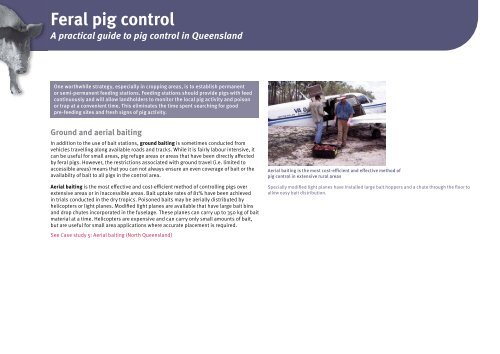Ipa Feral Pig Control Manual - Department of Primary Industries ...
Ipa Feral Pig Control Manual - Department of Primary Industries ...
Ipa Feral Pig Control Manual - Department of Primary Industries ...
You also want an ePaper? Increase the reach of your titles
YUMPU automatically turns print PDFs into web optimized ePapers that Google loves.
<strong>Feral</strong> pig control<br />
A practical guide to pig control in Queensland<br />
One worthwhile strategy, especially in cropping areas, is to establish permanent<br />
or semi-permanent feeding stations. Feeding stations should provide pigs with feed<br />
continuously and will allow landholders to monitor the local pig activity and poison<br />
or trap at a convenient time. This eliminates the time spent searching for good<br />
pre-feeding sites and fresh signs <strong>of</strong> pig activity.<br />
Ground and aerial baiting<br />
In addition to the use <strong>of</strong> bait stations, ground baiting is sometimes conducted from<br />
vehicles travelling along available roads and tracks. While it is fairly labour intensive, it<br />
can be useful for small areas, pig refuge areas or areas that have been directly affected<br />
by feral pigs. However, the restrictions associated with ground travel (i.e. limited to<br />
accessible areas) means that you can not always ensure an even coverage <strong>of</strong> bait or the<br />
availabilty <strong>of</strong> bait to all pigs in the control area.<br />
Aerial baiting is the most effective and cost-efficient method <strong>of</strong> controlling pigs over<br />
extensive areas or in inaccessible areas. Bait uptake rates <strong>of</strong> 81% have been achieved<br />
in trials conducted in the dry tropics. Poisoned baits may be aerially distributed by<br />
helicopters or light planes. Modified light planes are available that have large bait bins<br />
and drop chutes incorporated in the fuselage. These planes can carry up to 350 kg <strong>of</strong> bait<br />
material at a time. Helicopters are expensive and can carry only small amounts <strong>of</strong> bait,<br />
but are useful for small area applications where accurate placement is required.<br />
See Case study 5: Aerial baiting (North Queensland)<br />
Aerial baiting is the most cost-efficient and effective method <strong>of</strong><br />
pig control in extensive rural areas<br />
Specially modified light planes have installed large bait hoppers and a chute through the floor to<br />
allow easy bait distribution.
















